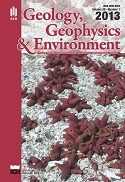Application of inverse Q filtering for improvement of seismic resolution in the Zechstein formation (SW Poland)
DOI:
https://doi.org/10.7494/geol.2013.39.1.33Keywords:
seismic resolution, attenuation, inverse Q filtering, Q factorAbstract
Seismic wave attenuation has strong, negative effect on the seismic data resolution. The high influence of this phenomenon was observed during realization of seismic survey "Duża Wólka 3D" (Geofizyka Kraków S.A. 2010a). The resolution of recorded seismic data was very low due to high attenuation caused by the Lower Triassic Buntsandstein sandstones. In consequence, interpretation of the thin-layered Zechstein formation is ambiguous. The aim of this paper is to present the multi-stage algorithm for the purpose of minimizing the attenuation effect, hence increasing the resolution of the seismic data. In order to achieve this, the inverse Q filtering process was used. The Q factor (quality factor) was estimated from the vertical seismic profiling data (Geofizyka Kraków S.A. 2010c). To verify the effectiveness of inverse Q filtering, seismic modelling was performed. Results received from seismic modelling gave basis for application the inverse Q filtering on real data. For this operation the seismic time profile inline 112 was chosen from the seismic data set "Duża Wólka 3D". Application of inverse Q filtering significantly increased the seismic resolution, which enabled the interpretation of the Zechstein formation with more accuracy.Downloads
References
Bardi M. & Mooney H.M., 1987. Q measurements from compressional seismic waves in unconsolidated sediments. Geophysics, 52, 772-784.
Blias E., 2011. Optimization Approach to Q-factor Estimate from VSP Data. 73rd EAGE Conference & Exhibition incorporating SPE EUROPEC 2011, Vienna, 23-26 May 2011.
Dasgupta R. & Clark R., 1998. Estimation of Q from surface seismic reflection data. Geophysics, 63, 288-290.
Dec J., Pietsch K. & Marzec P., 2011. Application of seismic methods to identify potential gas concentration zones at the Zechstein Limstone level in the "Rudna" mining area, SW Poland. Annales Societatis Geologorum Poloniae, 81, 63—78.
Geofizyka Kraków S.A., 2010a. Dokumentacja wyników badań sejsmicznych, temat - Sejsmiczne badania powierzchniowe Duża Wólka 3D. Archiwum KGHM Polska Miedź S.A. [unpublished report].
Geofizyka Kraków S.A., 2010b. Sprawozdanie końcowe z prac polowych, temat - Duża Wólka 3D. Archiwum KGHM Polska Miedź S.A. [unpublished report].
Geofizyka Kraków S.A., 2010c. Opracowanie wyników badań sejsmiki otworowej -S-421A. Archiwum KGHM Polska Miedź S.A. [unpublished report].
GeoGraphix Discovery Manual, 2009. LMKR, Dubai.
Hauge P.S., Measurements of attenuation from vertical seismic profiles. Geophysics, 62, 1548-1558.
Jarzyna J., 1999. Determination of attenuation of elastic waves in rock medium from interpretation of acoustic full wavetrains. Geofizyka w Geologii, Górnictwie i Ochronie Środowiska: V Konferencja Naukowo-Techniczna Jubileusz 50-lecia Nauczania Geofizyki w Akademii Górniczo-Hutniczej, Kraków 23 czerwca 1999, Akademia Górniczo-Hutnicza, Wydział Geologii, Geofizyki i Ochrony Środowiska, Zakład Geofizyki, Kraków.
Kłapciński J. & Peryt T.M., 1996. Budowa geologiczna Monokliny Przedsudeckiej. [in:] Piestrzyński A. (ed.), Monografia KGHM Polska Miedź S.A., Lublin, 69-77.
Norsar 2D Ray Modelling Manual, 2012. Norsar, Kjeller.
Pożaryski W., 1979. Mapa geologiczna Polski i krajów ościennych 1:000 000. Wydawnictwa Geologiczne, Warszawa.
Tonn R., 1989. Comparison of seven methods for computation of Q. Physics of the Earth and Planetary Interiors, 55, 259-268.
Wang Y., 2008. Seismic Inverse Q Filtering. Blackwell Publishing, Oxford.
Vista 2D/3D Seismic Processing 12 Manual, 2012. Gedco, Calgary.
Downloads
Published
Issue
Section
License
Authors have full copyright and property rights to their work. Their copyrights to store the work, duplicate it in printing (as well as in the form of a digital CD recording), to make it available in the digital form, on the Internet and putting into circulation multiplied copies of the work worldwide are unlimited.
The content of the journal is freely available according to the Creative Commons License Attribution 4.0 International (CC BY 4.0)










